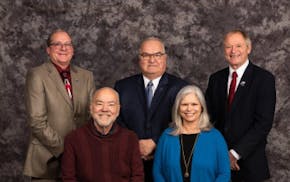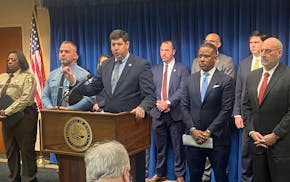Inver Hills Community College and Dakota County Technical College (DCTC) sit just 9 miles apart in Dakota County, have shared a president since 2015 and jointly employ 64 employees.
But the two schools, which opened in 1970, may soon become even more aligned, merging into a single college that officials say would be more efficient and better serve students. Plus, the merger would likely save about $500,000 per year.
"It allows us to create a richer, stronger experience for students [and] to be a preferred college for the south metro," said Michael Berndt, who has served as president of the colleges since 2020. "We'd be able to offer 100 programs of study, robust, inclusive support services and extensive business and community partnerships."
The two colleges, which are part of the Minnesota State system of 33 colleges and universities across the state, first need permission from the Minnesota State Board of Trustees, which could come up in January, Berndt said.
Across higher education, more mergers are happening as schools face financial and enrollment challenges.
"There are fewer students considering or attending [college] and we truly now have an oversupply of college options but not enough demand," said John Lawlor, who runs Lawlor Advisory, a Minneapolis-based higher education marketing firm.
Scott Olson, chancellor of Minnesota State, said enrollment declines are just one reason Inver Hills and DCTC are looking into a merger. Other goals, he said, include providing quality programs, meeting workforce needs and increasing efficiency. Olson said no other institutions in the system are currently considering a merger.
It's not the first time colleges in the system have come together, Berndt said. Nearly a dozen of its two-year colleges have merged with another institution at some point in their history, he said.
In northeastern Minnesota, five small colleges — Hibbing Community College, Itasca Community College, Mesabi Range College, Rainy River Community College and Vermilion Community College — joined forces in 2022 to become Minnesota North College.
Its president, Michael Raich, said "unnecessary duplication" was happening before the merger, such as the creation of individual budgets and financial aid reports, and data collection.
"We would send five recruiters to the same event to ... compete in enrollment," he said.
Students are more transient now, and some were already taking classes at multiple colleges anyway, Raich said.
"With any change comes a ... fear of the unknown. And so we ... made sure we were doing the best we could to positively manage emotions throughout the process," he said.
How two colleges merge
DCTC, which is in Rosemount on County Road 42, offers more than 50 programs. Its student athletes — the Blue Knights — compete in National Junior College Athletic Association (NJCAA) Division 2 sports. The college enrolled 3,211 students this fall.
In Inver Grove Heights, Inver Hills students can choose from more than 40 programs. The college aims to provide general education credits, including many in the liberal arts, so students can eventually transfer to a four-year institution. Its 5,266 students can participate in arts activities at the school.
The two colleges moved to a "shared administration model" in 2015, when Tim Wynes became their joint president. Today, about 100 students take classes at both, Berndt said, but "it's not very elegant."
Combining some jobs and looking for efficiencies, a process that has been ongoing for more than a decade, already saves $3.7 million annually, he said.
The merger needs approval from the colleges' accreditor, the Higher Learning Commission, and then the schools would make a plan called a "change of control" application. The federal and Minnesota education departments would also weigh in.
If the merger takes place, students will get the chance to share more, Berndt said, adding that the colleges have different but complementary missions. The merger would give students access to more than 100 programs and a "richer collegiate experience" with shared extracurriculars in sports and the arts, which can only happen now if they attend classes at both schools, he said.
More courses, including online and hybrid options, would be offered at more times, Berndt said.
"If a student comes to us and is interested in health care but they're not really sure what program they're interested in ... we can help them navigate that and start to coordinate the kind of courses they would need to keep their options open," he said.
Each campus would still offer student services, he said. Officials would have to be creative with technology, Berndt said, so they could balance being "lean and efficient" with meeting students' needs.
The hope, however, is to keep students at one campus as much as possible so those with less reliable transportation aren't disadvantaged, he said, adding that transportation is "an ongoing challenge" for the county.
Berndt said that while not everyone on the campuses is excited by the merger, "there's certainly cautious interest" even among those most invested in the schools' individual identities.
Raich, at Minnesota North College, said the schools didn't lay off employees when they merged but took advantage of upcoming retirements in overstaffed areas.
The merger allowed the college to offer core classes, such as English, at every campus as part of "one big department" while letting other campuses retain successful niche programs; the Hibbing campus kept the heavy equipment diesel maintenance program, for instance, since duplicating it elsewhere would be too expensive.
Faculty, students react to change
Faculty and former students at DCTC and Inver Hills said they hope officials take their needs seriously as the next steps develop.
Laura Funke, an English instructor at Inver Hills, said the merger has generated "nervous excitement" among the school's faculty. In an email, she said members are excited about collaborating with DCTC instead of competing for enrollment and about the ways students could benefit.
"At the same time, faculty are tense about issues such as potential layoffs, closing of programs and seniority," she said. "We look forward to working closely with the DCTC faculty to ensure that faculty have a strong voice in merger discussions."
While there were no public talks of a merger when she attended Inver Hills in 2021 through 2023, Karina Villeda remembered that some advisers and other staff worked with students from both schools. There were a lot of joint campus events during that time, too, she said.
"It really started happening a lot my last year there," Villeda said of the events.
Villeda, now a University of Minnesota senior, said she thinks the merger would make a "good combination." She said that if it happens, keeping each campus' student support system intact would be important.
"It would just be very inaccessible if, for example, you moved the food pantry just to Inver Hills or the mental health counseling services just to DCTC," she said, adding that she previously volunteered at the food pantry. "I just wish them luck in doing that transition."

As Rep. Angie Craig takes her town halls to greater Minnesota, Republican colleagues say she may be violating House ethics rules

Gov. Walz excoriates Trump, offers olive branch to MN Republicans in State of the State speech

Minnesota county commissioner, whose wife wanted him to step down due to cognitive concerns, resigns

Federal jury convicts three Minneapolis 'Highs' gang members of murder, racketeering

